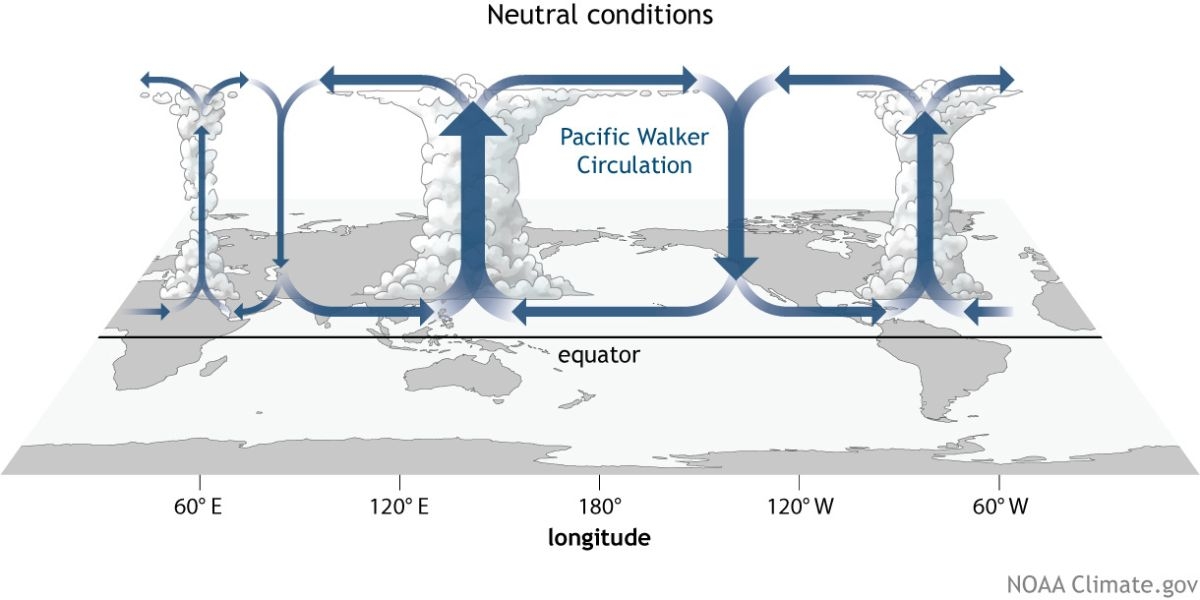

Via UCSB THE CURRENT
The Pacific Ocean covers 32% of Earth’s surface area, more than all the land combined. Unsurprisingly, its activity affects conditions around the globe.
Periodic variations in the ocean’s water temperature and winds, called the El Niño–Southern Oscillation, are a major meteorologic force. Scientists know that human activity is affecting this system, but are still determining the extent. A new study in Nature has revealed that the atmospheric component — called the “Pacific Walker Circulation” — has changed its behavior over the industrial era in ways that weren’t expected. The international team of authors also found that volcanic eruptions can cause the Walker Circulation to temporarily weaken, inducing El Niño conditions. The results provide important insights into how El Niño and La Niña events may change in the future.
“The question is, ‘How does the background circulation change?” said co-author Samantha Stevenson, an associate professor at UC Santa Barbara’s Bren School of Environmental Science & Management. “We care about the Walker Circulation because it affects weather around the world.”
Earth’s rotation causes warm surface water to pool on the western side of ocean basins. In the Pacific, this induces more humid conditions in Asia, with low-altitude trade winds blowing west across the sea. The high-altitude easterlies create an atmospheric circulation — the Walker Circulation — that drives weather patterns in the tropical Pacific, and far beyond.
“The tropical Pacific has an outsized influence on global climate,” said Sloan Coats, study co-author and assistant professor of earth sciences in the University of Hawai‘i at Mānoa School of Ocean and Earth Science and Technology. “Understanding how it responds to volcanic eruptions, anthropogenic aerosols and greenhouse gas emissions is fundamental to confidently predicting climate variability.”
These effects leave biologic and geologic signatures. The team used data from ice cores, trees, lakes, corals and caves to investigate the long-term weather patterns of the Pacific over the past 800 years.
“They aren’t thermometers, but they contain information about the climate,” Stevenson said.
Certain conditions favor uptake of heavier or lighter versions of an element, called an isotope, into structures like carbonate skeletons, sediment and tree rings. The researchers used sophisticated statistics to analyze the ratios of different types of oxygen and hydrogen. This allowed them to track how the Walker Circulation changed in the past and compare trends from before and after the rise in greenhouse gases.
“We set out to determine whether greenhouse gases had affected the Pacific Walker Circulation,” said lead author Georgy Falster, a research fellow at the Australian National University and the ARC Centre of Excellence for Climate Extremes. “We found that the overall strength hasn’t changed yet, but instead, the year-to-year behavior is […]
Full article: mavensnotebook.com
Clean water is essential for life, yet millions of Americans unknowingly consume contaminants through their…
Human brains contain higher concentrations of microplastics than other organs, according to a new study, and the…
From the Office of the Governor: In anticipation of a multi-day, significant atmospheric river in Northern California,…
From Governor Newsom: Scientists, water managers, state leaders, and experts throughout the state are calling…
Photo: A harmful algal bloom in Milford Lake, Kansas, made the water appear bright green.…
An expanded plastic foam coffee cup is at a donut shop in Monterey Park, California.…